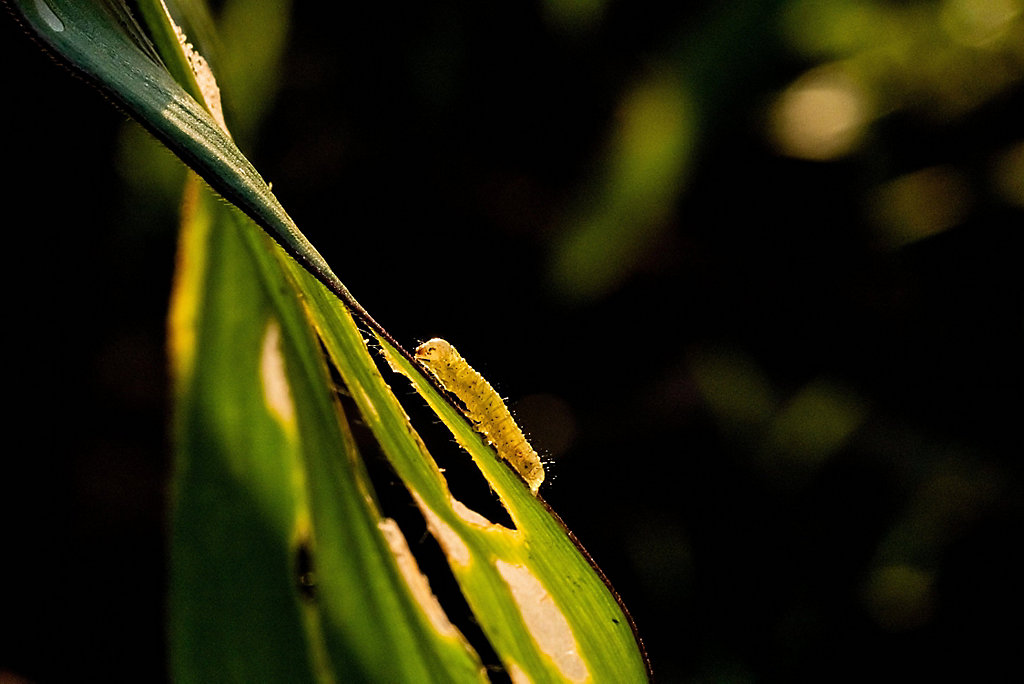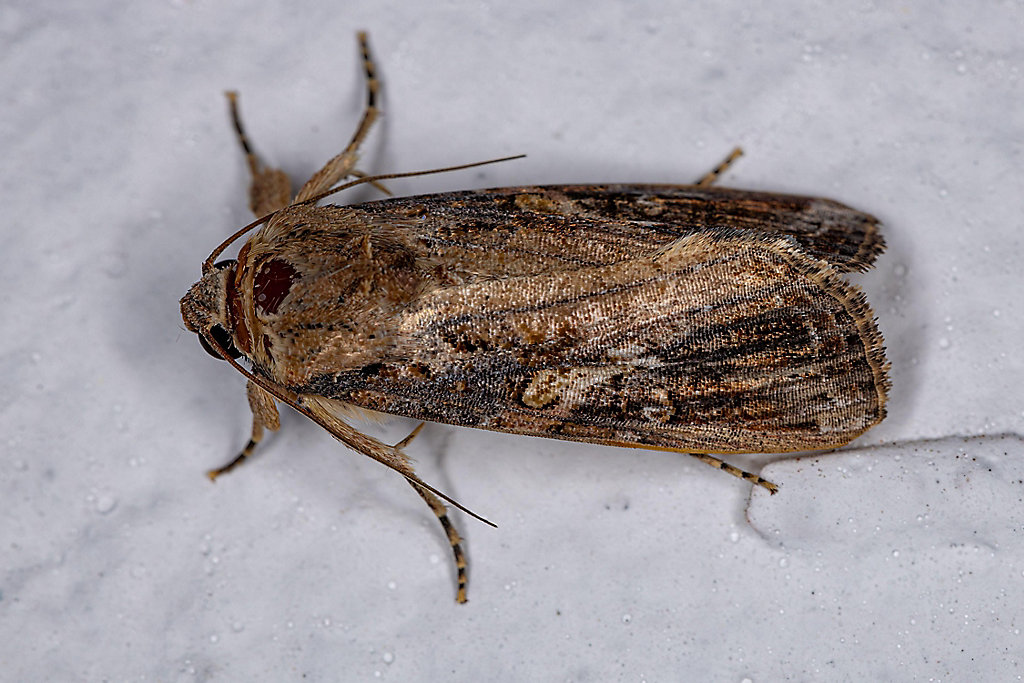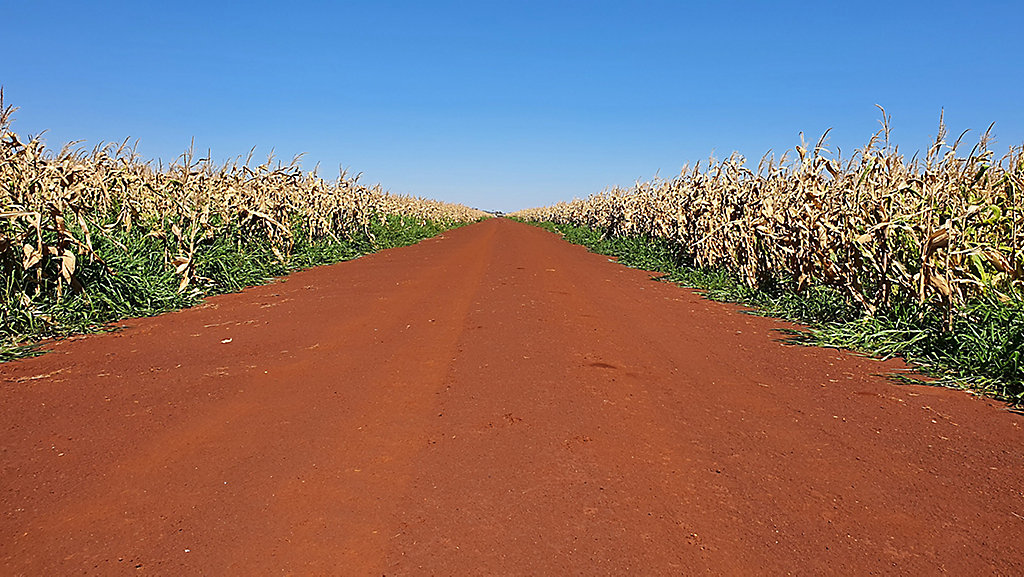Fall armyworm poses a dire threat to cereal supplies worldwide. Here’s how we’re fighting back.
In early December 2018, when his maize was waist-high, Prafull Devraye noticed ragged holes in the leaves. Closer inspection of the damage confirmed the Maharashtra farmer’s worst fears: his crop was infested with Spodoptera frugiperda, better known as fall armyworm (FAW)—a pest unknown in India prior to that August.
Devraye, who has a degree in agriculture, assessed his options and arrived at an unwelcome decision: do nothing. “It was too costly and too late to spray,” he says. The following year, by cultivating soybeans and cotton instead of corn, he managed to avoid FAW. He has yet to plant corn again. At least for now, the smallholder says, “this is the strategy that makes the most sense.” For Devraye, perhaps—but not for the world.
As of 2021, FAW was decimating cereal and forage crops in 109 countries across Africa, the Middle East, South and East Asia, and Oceania.1 While it feeds on more than 300 plant species, FAW shows a strong preference for corn.2 And because corn is the staple of not only the modern food system, controlling FAW is essential for food security and food production.3
Fortunately, an effective strategy and impressive arsenal are at hand. By integrating improved seed, proven agronomic practice, and biologic and chemical crop-protection tools, farmers can outmaneuver this formidable foe.
Prevention and detection
FAW isn’t a new threat. Farmers from Brazil to Canada have been managing it for more than a century.4 But global trade and a warming climate have expanded its territory.
FAW spreads by air during its moth phase. Strong-flying moths migrate from tropical and temperate climates to deposit their egg masses—1,500 to 2,000 or more per female—on leaves, grasses, and light-colored surfaces. The eggs hatch into larvae that become, through six phases and about 30 days, 1.5-inch-long eating machines. After four days of feasting, the caterpillars burrow into the ground and form pupae, from which the next generation of moths will emerge and take wing.5
FAW’s invasion of Africa in 2016 garnered world attention and mobilized an corps of researchers and agronomists.6 Organizations like CIMMYT (the International Maize and Wheat Improvement Center) and CGIAR, a global agricultural research partnership, performed extensive field research to surface economically and environmentally sustainable ways to control FAW and save crops.7 In 2019, the Food and Agriculture Organization of the United Nations set up Global Action for Fall Armyworm Control. The $500 million three-year initiative (2020–2022) has trained extension officers and farmers throughout Africa, Asia, and the Middle East to identify, scout for, and report FAW. It has also equipped them to manage infestations without resorting to blanket pesticide applications, a practice which has contributed to increased pesticide resistance.8 As a result, smallholders are gaining the control previously enjoyed only by large commercial growers in the Americas.
Breeding resistance
In FAW management, an ounce of prevention is worth literally tons of cure. Seed-based technologies that increase plant resistance to FAW represent the most effective as well as affordable and available crop protection. They don’t eliminate the need for pesticides. But they dramatically reduce their application, lowering farmers’ input and labor costs.The first of these technologies is the genetic modification of seeds to incorporate Bacillus thuringiensis, a bacterium that kills FAW. So-called Bt corn has controlled FAW in the Americas for the last 15 years and accounts for the success of commercial maize crops in South Africa. Bt corn is seen as an important technology for small-scale growers in China.9 Bt-treated seed is another way to augment corn’s resistance to FAW.
However, because FAW can be resistant to Bt crops, scientists are now focused on breeding plants to be resistant to FAW. Corn hybrids developed for eastern and southern Africa, for example, marry insect-resistant germplasm drawn from Mexico with stress-resilient germplasm developed in sub-Saharan Africa. National and regional tests performed in 2020 suggest that these hybrids could reduce crop losses in sub-Saharan Africa by a factor of 8.6.10
Better field tactics
Field practices that foster plant health augment both natural and engineered host-plant resistance. These include suppressing weeds by not tilling the soil and keeping fields free of vegetation that might shelter FAW or make it easy for larvae to move from plant to plant.11 Many Africans are no longer intercropping with pumpkin, for example, as pumpkin has been shown to act as a bridge for the pest.12Invented decades ago but newly relevant in the fight against FAW is the “push/pull” strategy. Intercropping with vegetation that FAW won’t eat pushes the insect from the cash crop, while bordering fields with vegetation that FAW desires pulls them away. A 2018 study in Kenya, Uganda, and Tanzania found that farmers reduced FAW infestation by 80 percent simply by planting Desmodium (a legume repellent to FAW) between rows of corn and Brachiaria (a grass attractive to FAW) around the field.13

Other effective tactics include enlisting FAW’s natural enemies. In Niger, researchers found two parasitic wasps, Telenomus remus and Trichogramma, that attack FAW. With CGIAR’s help, they taught extension agents and farmers from 16 countries how to scout, collect, and culture the eggs. Studies of the use of this tactic on other pests show that by mass-producing and releasing the wasps early in the growing season, farmers can control FAW.14
The big guns
Insecticides continue to play a powerful role in integrated pest management.As proper application is what maintains the potency of this arsenal, agrochemical associations, agriscience companies, and CABI have banded together to train growers in proper technique. Growers learn how to identify the pest, how to trap it and scout for it, and how to keep a close eye on their crops throughout the season so that they don’t miss the window in which spraying is cost-effective. Sprays are most economical when 75 percent of plants exhibit whorl-feeding damage and larvae are less than 1-1/4 inches (31 mm) long.15
Favorable outcomes depend on applying pesticide at the right time and applying the right pesticide. Both smallholders and largeholders should always consult with local extension agents and crop-protection experts to learn what is licensed and effective against FAW in their geographical area.
Next-gen genomic tactics
As FAW continues its assault, agriscience continues to innovate protections against it.One of the more promising initiatives under development is genetically modifying moths to pass along a gene that results in the mortality of female offspring.16 In March 2022, corn growers in the Brazilian state of São Paulo participated in a pilot program whereby moths carrying this gene were released into the wild to mate with females. As Brazil is the world’s third-largest corn producer and exporter, this approach will be closely studied as a solution to FAW in corn belts worldwide.
Another innovation with vast potential is a new class of pesticides that work by interfering with FAW’s cellular growth and function, a technique known as RNA interference (RNAi).17 Researchers have found that by targeting four genes affecting FAW’s development and fertility, RNAi can suppress the insect’s reproduction and survival.18

Whatever the next weapon is, agronomists agree that it must be part of an integrated strategy. “Biointensive pest management can be a sustainable solution, both for farmers and for the environment,” says Dr. Malvika Chaudhary, the regional coordinator for Asia for CABI’s Plantwise program. “But not all the components of this strategy are readily available to all farmers, which hampers adoption.”
That’s why knowledge sharing may be the most important weapon in the global FAW arsenal. “Farmers don’t yet fully understand armyworm behavior or its response to management,” says Chaudhary. “To defeat this enemy, we’ve got to build their capacity to know it.”
End Notes
1 https://www.ippc.int/en/the-global-action-for-fall-armyworm-control/2 https://www.cabi.org/isc/datasheet/29810
3 https://neobiota.pensoft.net/article/62844/element/4/427/
4 https://www.cgiar.org/research/publ...-asia-a-guide-for-integrated-pest-management/
5 https://ipmil.cired.vt.edu/wp-content/uploads/2018/01/paper-1.pdf
6 https://www.fao.org/fall-armyworm/en/
7 https://www.cgiar.org/research/publ...-asia-a-guide-for-integrated-pest-management/
8 https://www.ippc.int/en/the-global-action-for-fall-armyworm-control/fao-global-action/
9 https://onlinelibrary.wiley.com/doi/full/10.1111/1744-7917.12826
10 https://www.cimmyt.org/news/announc...aize-hybrids-for-eastern-and-southern-africa/
11 https://www.cimmyt.org/news/new-stu...mic-practices-to-reduce-fall-armyworm-damage/
12 https://www.sciencedirect.com/science/article/pii/S0261219419300304
13 http://www.icipe.org/news/icipe-push-pull-technology-halts-fall-armyworm-rampage
14 https://www.cgiar.org/news-events/n...-for-the-biological-control-of-fall-armyworm/
15 https://extension.entm.purdue.edu/fieldcropsipm/insects/fall-armyworm.php
16 https://bmcbiotechnol.biomedcentral.com/track/pdf/10.1186/s12896-022-00735-9.pdf
17 https://www.forbes.com/sites/michae...se-of-a-new-green-revolution/?sh=4cd8c9e478e7
18 https://academic.oup.com/jinsectscience/article/21/5/8/6377270





